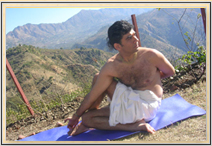Yoga defined and origin
Q.1) What is the definition of yoga?
Before I state my definition of yoga, I would like readers to know that there are two authoritative definitions of yoga in public domain.
One from Maharishi’s Paatanjali’ Yoga sutra and another from Shree Krishna in Bhagwad Geeta.
The philosophically rich one from Maharishi Paatanjali defines yoga as that state, where the consciousness overcomes its inherent tendency to project manifestations.
In these few words the entire secret or mechanism of the creation is brought forth.
That the creation with all its distinctions and multitude manifestations springs from the one single indivisible consciousness, through its tendency to experience its creation.
That there are no two, leave multiple entities, but just one entity in this cosmos.
That what we see as so many creatures are but one consciousness experiencing its own creation through all the creatures it created.
Thus when consciousness stops its tendency to ‘play’ the world, then being one with itself and undeluded, it achieves yoga.
The matter of factly definition of yoga from Shree Krishna, states (verse 48 of chapter two Bhagwad Geeta) The state of equanimity, unperturbed in success and failure and opposites, is called yoga.
By this definition a yogi is one who remains even minded in the various swings of life and is equally at peace in a busy market as in a solitary place.
I accept both the above definitions as conveying the same and to be a true definition of yoga. I would further elaborate that yoga is but being one with one’s reality. The reality beyond what is perceived through the senses. The reality experienced, which is beyond the cognition of mind. To be in that state while living in the world is called being established in yoga.
There may be various processes, techniques employed by different aspirants based on their temperament and the practitioners of such techniques are also referred as yogis. For example the man who is trying to control the restless of his mind and preparing for meditation and is doing yogasana is also called a yogi. Just as a man pursuing spiritual knowledge or path of devotion or service is also called yogi. This is as they all are working to reach the same state. That of yoga.
Q.2) How do you trace the origin of yoga?
Shree Krishna mentions in the 4th chapter of Bhagwad Geeta that He had Himself given this knowledge to Sun god and when the chain of knowledge got disturbed over time, He conveyed the same to Arjuna during the course of Bhagwad Geeta.
As far as the tracing the origin of the now hugely popular yogasnas, then that is traced to Lord Shiva. Once finding Shiva alone at a deserted island, His wife Parvati asked Him, as the material influences are increasing and people’s minds being restless find it difficult to concentrate, how would they meditate? So wouldn’t the path of yoga through meditation disappear ?
Lord Shiva then mentioned that how bodily postures and techniques can be used to overcome the restlessness of the mind and this knowledge of hatha yoga would come to aid of those who otherwise would find it difficult to still their mind to meditate.
A fish near the shore heard this dialogue and by its power transformed instantly to a yogi and was called Matsyendranath by Lord Shiva.
Matysedranath after perfecting all the yogic techniques and becoming the master, asked Lord Shiva for a disciple who can promote this hatha yoga. Lord Shiva said that as there is no worthy recipient for this work, He Himself would materialize as the disciple of Matsyendranath. Accordingly in due course from sacred ash given by Lord Shiva to Matsyendranath, a boy called Gorakshanath materialized. He was thus named as he was in the protection of cows in a cow shed till early childhood.
Together these great masters Matsyendranath and Guru Goarakshanath made 7 more great masters from ordinary mortals and they all set up a chain of yogis and the same continues till now.
Shukl’acharya, is the founder of Shuklacharya’s Retreat & Spiritual Centre in Bhimtal Uttarakhand Indian Himalayas. Now with about 40 years of yogic pursuits, Shuklacharya- has been a guide to many westerners in ancient yoga and vedic philosophy, He was recognized and honoured at Guru Sangamam in April 2012’ amongst the 108 spiritual leaders in contemporary India.
